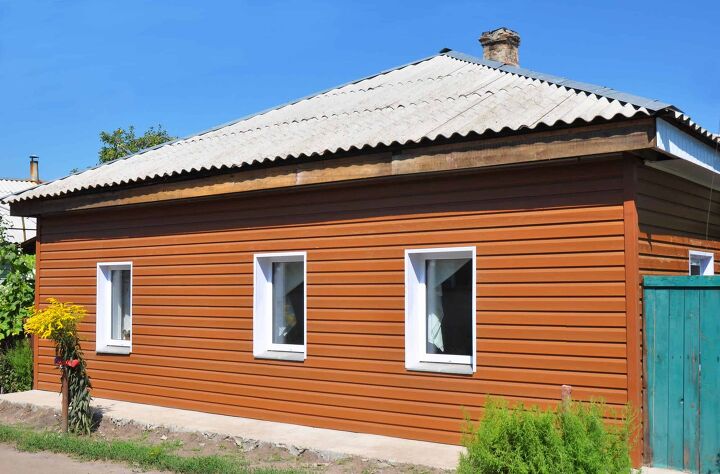Should I Buy A House With Asbestos Siding?

Many people recoil at the thought of being near asbestos. But you might be surprised to learn how common it is in older homes. If you’re thinking about buying a house with asbestos in the siding, the best thing to do is be informed. Learn more about it and the potential risks.
Buying a house with asbestos comes down to personal choice. Health experts largely agree that as long as the asbestos securely contained, it should not pose a threat. It is more dangerous to disturb asbestos by removing it than to leave it alone.
In this article, we’ll discuss the possible risks of buying a house with asbestos, and how to proceed.
Do You Need Absestos Testing Services?
Get free, zero-commitment quotes from pro contractors near you.

What is Asbestos?
People often have reservations about buying a home with asbestos in the siding. But the truth is, a lot of people also don’t know much about it. They know that it can be harmful, but not why, or when it becomes a danger.
Asbestos is a group of 6 naturally occurring minerals that are made out of thin, microscopic fibers. Its individual fibers are not visible to the naked eye. The fibers are sharp and needle-like. When asbestos was discovered it quickly became a popular material to build with. Asbestos is heat-resistant, chemical-resistant, durable, and useful for fireproofing.
Asbestos mining was common through the late 1900s. Mining stopped when the last mine was closed in 2002. There are many naturally occurring asbestos deposits located around the United States. Asbestos continues to be imported to the US, mainly from Russia.
Although it is not nearly as widely used today, there are still small amounts of it used in certain products.
What are the Risks of Asbestos Exposure?
Researchers first reported that asbestos exposure was harmful in the early 1900s. This happened when they discovered a link between asbestosis and lung cancer in miners and asbestos factory workers.
Asbestos fibers can be released into the atmosphere when broken up or during abrasion. This was common in mines and factories.
We now know the many risks associated with exposure to asbestos. It is dangerous when inhaled or swallowed. Asbestos can become embedded in the organ linings and tissues, and cause a myriad of health issues years later.
Some of the diseases caused by asbestos include:
- Mesothelioma: This is a rare form of cancer found in the lining of the lung, chest, abdomen, and heart
- Asbestosis: This is a serious, long-term, non-cancer lung disease
- Lung cancer
Although the US has greatly reduced its use of products containing asbestos, it’s not gone completely. People may be at risk while being around asbestos-containing material during demolition work, building, home maintenance, repair, or remodeling.
What Can Contain Asbestos?
If your house was built before the 1980s, there’s a good chance that some of the building materials involved asbestos. This was before there were any major legal challenges against its use.
Common home materials that may still contain asbestos include:
- Attic and wall insulation that contains vermiculite
- Roofing and siding shingles
- Textured paint (i.e. “popcorn ceilings”)
- Walls and floors around wood-burning stoves that are protected with asbestos paper, millboard, or cement sheets
- Hot water and steam pipes may be coated with asbestos material
- Electrical breakers
- Pasters
- Sheetrock
- Caulking
- Concrete
- Wiring
- Siding
- Vinyl floor tiles
Is a House with Asbestos Siding Safe?
The presence of asbestos siding doesn’t have to be a deal-breaker. Asbestos is only an issue when the fibers are released into the air. This is when they can cause lung damage. Inhaling asbestos fibers can happen during a renovation.
If the siding isn’t cracked or broken, the asbestos will stay embedded into the boards. You will not have to worry about breathing in the fibers.
Siding is also one of the lower-risk places to have asbestos in. Since siding material is non-friable, it poses less of a threat. Non-friable means that the material doesn’t easily crumble or break by hand. As long as it’s contained within other materials, it is considered safe.
Because of the misconceptions about houses containing asbestos, you may even be getting a better deal on a house. Many homeowners tend to underprice their homes that have asbestos, assuming that no one will want to pay full price.
If you decide to spring for the house, you can set up an asbestos survey. This will assess the potential hazard and any airborne presence of asbestos. They will be able to identify exactly where it is and whether it needs to be removed.
Will I Have Trouble Selling It?
If you don’t plan on being in your next home forever, you might be worried about selling a house with asbestos. Some people assume that the value of their home will greatly decrease from having asbestos contained in it.
But many real estate professionals report that they hardly ever have issues selling houses with asbestos present. Because of how common it is, and the minimal threat when it’s not disturbed, many people are not bothered by the presence of it. Realtors are also generally good about disclosing possible risks and easing worries about things that are not a threat.
Does the Asbestos Need to be Removed?
Surprisingly, building and health experts recommend you don’t remove the asbestos from your home. Living in a home with asbestos contained in the siding is actually safer than removing the asbestos.
It is safe to live there as long as the siding is not disturbed. Seal it off with an airtight sealant to keep it in its place.
Sooner or later, however, you may want to repair or replace the siding. This will require stringent safety measures. There are government regulations for removing and safely disposing of asbestos.
To remove the asbestos, you might want to hire a professional asbestos contractor, which will be expensive. These professionals are pricey since they charge you extra for safe removal and disposal.
If you hire a professional, you may be able to encapsulate the materials in the basement instead of removing them. This will save you from having to pay disposal costs.
Can I Remove Asbestos Myself?
Any professional you ask will likely attempt to dissuade you from attempting asbestos removal yourself. Since asbestos poses a health hazard, many people think it’s best to leave it to the professionals.
But if you think you can perform the job safely and accurately, it can be an option. The good news is that there is a ton of information on the proper procedures for asbestos removal and disposal.
Do You Need Absestos Testing Services?
Get free, zero-commitment quotes from pro contractors near you.

Related Questions
How much does it cost to remove asbestos siding?
The cost of removing asbestos siding depends on how big the area is. Professionals usually charge by the square foot to remove it. Encapsulation costs on average $2-$6 per square foot. The average cost to repair siding is anywhere from $665 to $8856.
What is encapsulation?
Encapsulation is a popular form of dealing with asbestos. It involves covering the material with a sealant material that embeds the fibers inside of it. This prevents the asbestos from releasing fibers.

Kathryn is a craft aficionado who loves writing about DIY home improvement projects. When she's not writing, she loves reading, listening to musicals, and playing with her kids.
More by Kathryn Flegal



























